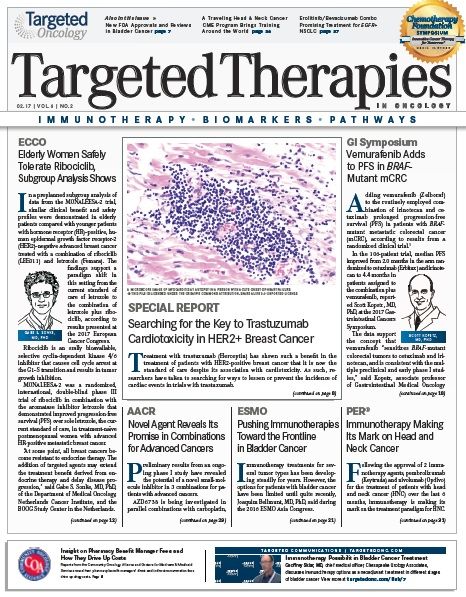Mutational Load is Only One Piece of the Immunotherapy Puzzle
As immunotherapies become a greater part of the treatment paradigm of various cancers, researchers are spending more time developing ways to determine which patients will respond better to immunotherapy. Mutational load is one such biomarker that appears to have an impact on response to immunotherapy, particularly for checkpoint inhibitors.
Caroline Robert, MD, PhD
As immunotherapies become a greater part of the treatment paradigm of various cancers, researchers are spending more time developing ways to determine which patients will respond better to immunotherapy. Mutational load is one such biomarker that appears to have an impact on response to immunotherapy, particularly for checkpoint inhibitors, with some trials showing a correlation between patients with a higher mutational burden and better responses to immunotherapy agents.
While mutational burden and response to immunotherapy are potentially linked, mutational load alone is not a sufficient enough influence on response to affect treatment decision making, Caroline Robert, MD, PhD, said during a presentation at the 2016 ESMO Asia Congress.
Speaking in a debate against the importance of mutational load on clinical response to immunotherapy, Robert, head of the Dermatology Unit at the Institut Gustave-Roussy, suggested that perhaps the formula for patient response to immunotherapy is much more complex.
A study by Van Allen et al showed a correlation between response to ipilimumab (Yervoy) in patients with metastatic melanoma and both mutational load (P = .0076) and neoantigen load (P = .027).1Patients with a higher mutational and/or neoantigen load were more likely to show a clinical benefit to ipilimumab therapy. However, among the 40 patients for which transcriptome data were obtained and analyzed, no common neoantigen could be found that could be used in selecting patients for therapy with ipilimumab. In addition, a great deal of overlap was noted between the patients who did and did not respond in terms of both mutation and neoantigen load.
In an analysis of patients with metastatic urothelial carcinoma, which has often been studied for its association with mutational load, Robert pointed out that in the IMvigor 210 trial, patients’ mutational load was tested with the FoundationOne 315-cancer gene panel. Similarly, mutational loads were greater in the patients who responded to treatment with atezolizumab (Tecentriq) than in the non-responders (P <.0001).2 A correlation to both progression-free (P = .003) and overall survival (P = .014) was also noted. However, these associations were found to be statistically independent of other predictors of response.
“Clinically it doesn’t seem to be helpful,” Robert said. Instead, she suggested that perhaps mutational load may be a prognostic biomarker rather than a predictive biomarker.
A tumor genome analysis of over 500 patients with cancers in 6 tumor sites showed that there was no difference in survival between patients with high mutation counts and low mutation counts (P = .55).3There was a statistical significance, though, between patients with at least 1 immunogenic mutation and higher survival rates (P = .0021). Concordance was also noted between immunogenic mutation count and CD8, PD-1, and CTLA-4 expression (P = .000001).
The mutational burden should not change the way oncologists treat their patients, Robert said, as it is not a complete picture of response to immunotherapies. “I see this as very important raw data that are necessary, but are not sufficient to mount an efficient immune response.”
Instead, mutational load could be 1 piece of a more integrated and complex algorithm determining a patient’s response to immunotherapy. This algorithm, Robert suggested, could also include considerations of the genetics of the host; tumor-specific parameters, including neoantigens, microsatellite instability status, and immune targets; tumor microenvironment, and the microbiome.
An association between mutational load and cytolytic activity has been suggested, especially as they yield neoepitopes and bind to the human leukocyte antigen (HLA). However, cytolytic activity inversely affects mutational load through immunoediting, as was seen in melanoma T-cell interactions.4
“We know that it’s not sufficient to have a lot of mutation, we also have to prime correctly, we also have to have T cells that are able to extravasate the vessels and go back to the tumors where they could still be facing resistance mechanism,” Robert said.
In an analysis of the association between PD-L1 expression, cytolytic activity, and mutational load studied across 9 tumor types, a wide difference was found between each of the tumor types with all 3 of the parameters, proving the interdependent nature of each of the parameters.5The investigators noted that future biomarkers for antiPD-1/PD-L1 therapy would benefit from tumor-specific, integrated, and genomic approaches.
While the influence of mutational load should change the way oncologists see responses to immunotherapy, Robert said, it should not change the way that they treat patients.
References:
- Van Allen EM, Miao D, Schilling B, et al. Genomic correlates of response to CTLA-4 blockade in meta- static melanoma. Science. 2015;350(6257):207-211. doi:10.1126/science.aad0095.
- Rosenberg JE, Petrylak DP, Van Der Heijden MS, et al. PD-L1 expression, Cancer Genome Atlas (TCGA) subtype, and mutational load as independent predictors of response to atezolizumab (atezo) in metastatic urothelial carcinoma (mUC; IMvigor210). J Clin Oncol. 2016;34(suppl; abstr 104).
- Brown SD, Warren RL, Gibb EA, et al. Neo-antigens predicted by tumor genome meta-analysis correlate with increased patient survival. Genome Res. 2014;24(5):743-750. doi:10.1101/gr.165985.
- Verdegaal EM, de Miranda NF, Visser M, et al. Neoantigen landscape dynamics during human melanoma- T cell interactions. Nature. 2016;536(7614):91-95.
- Danilova L, Wang H, Sunshine J, et al. Association of PD-1/PD-L axis expression with cytolytic activ- ity, mutational load, and prognosis in melanoma and other solid tumors. Proc Natl Acad Sci U S A. 2016;113(48):E7769-E7777.

Survivorship Care Promotes Evidence-Based Approaches for Quality of Life and Beyond
March 21st 2025Frank J. Penedo, PhD, explains the challenges of survivorship care for patients with cancer and how he implements programs to support patients’ emotional, physical, and practical needs.
Read More